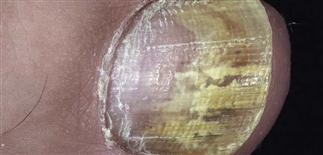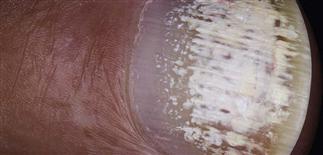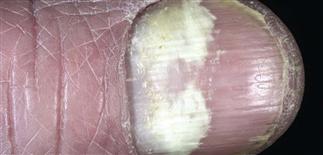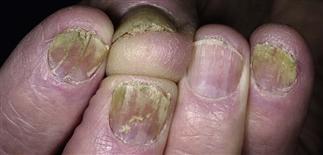153
Fungal nail infections

Distal subungal onychomycosis. Scrapings from distal aspect under nail plate are often positive in KOH. If negative KOH, consider culture prior to treatment.

White superficial onychomycosis. Chalky white scrapings taken from the nail surface are KOH positive.

Proximal subungal onychomycosis. The nail surface is smooth. The infection is beneath the nail plate.

Multiple finger nails affected by onychomycosis. A positive KOH or culture is advised before treatment. Infection can be spread to skin by scratching.
DESCRIPTION
Onychomycosis: fungal infection of fingernail or toenail plate. Cause: many different species of fungus.
HISTORY
• Trauma from tight-fitting shoes that are too short predisposes to infection. • A large mass composed of a thick nail plate and underlying debris may cause discomfort with footwear.
PHYSICAL FINDINGS
There are four distinct patterns. Several patterns may occur simultaneously. • Distal subungual onychomycosis. Most common pattern. Fungi invade distal area of nail bed. Distal plate turns yellow or white as an accumulation of thick scaling debris causes nail to rise and separate from underlying bed. • White superficial onychomycosis. Caused by surface invasion of nail plate, most often by Trichophyton mentagrophytes. Nail surface is soft, dry, powdery, and can easily be scraped away. Nail plate is not thickened. • Proximal subungual onychomycosis. Microorganisms enter the area of posterior nail fold cuticle, invade nail plate from below. Surface remains intact. Hyperkeratotic debris causes nail to separate. Trichophyton rubrum is most common cause. • Candidal onychomycosis. Nail plate infection caused by Candida albicans is seen almost exclusively in chronic mucocutaneous candidiasis, a rare disease. Generally involves all the fingernails. Nail plate thickens and turns yellow-brown.
All nails and skin are examined to rule out other diseases, such as psoriasis, that mimic onychomycosis.
Aspergillus, Cephalosporium, Fusarium, and Scopulariopsis species, considered contaminants or non-pathogens, can also infect nail plate. Multiple pathogens may be present in a single nail. In a potassium hydroxide wet mount, subungual debris and nail plate are examined for hyphae. Culture to establish presence of dermatophytes— organisms susceptible to itraconazole (Sporanox), terbinafine (Lamisil), and fluconazole (Diflucan).
TREATMENT
• Topical antifungal creams. Little value. Poor nail penetration.. • Oral therapy. Highest success rate in fingernail and toenail infections in young persons. • From 50% to over 80% effective. Relapse rate approximately 15–20% in 1 year. Indications for treatment include pain with thick nails, functional limitations, secondary bacterial infection, and arguably, appearance. • Terbinafine (Lamisil) 250 mg q.d. Administered for 6 weeks for fingernail infection, 12 weeks for toenail infection. Not effective for some candidal species. • Itraconazole (Sporanox) 200 mg q.d. Prescribed for 6 weeks for fingernail infection, 12 weeks for toenail infection. Pulse dosing with 200 mg b.i.d. for 1 week on then 3 weeks off another option. Fingernail infection: two or three pulses. Toenail infection: three or four pulses.







